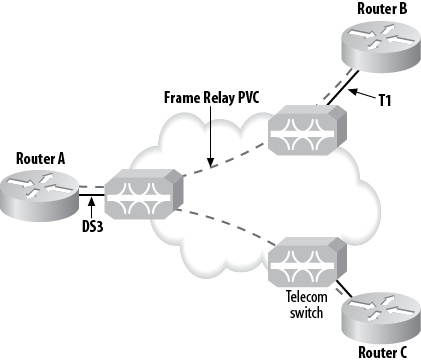Chapter 23. Frame Relay
Frame Relay is a method of transporting digital information over a network. The data is formatted into frames, which are sent over a network of devices usually under the control of a telecommunications company. Diagrams depicting Frame Relay networks often display the network as a cloud, as the end user doesnât generally know (or care) how the network is actually designed. The end user only needs to know that virtual circuits (VCs) through the cloud will allow the delivery of frames to other endpoints in the cloud.
Whatever goes into one end of the VC should come out the other end. The far end appears as though it is on the other end of a physical cable, though in reality, the remote end is typically many hops away.
The VCs may be either switched or permanent. A Frame Relay permanent virtual circuit (PVC) is always up, even if itâs not in use. A switched virtual circuit (SVC) is up only when itâs needed. Most data networking deployments use PVCs.
Figure 23-1 shows a typical simple Frame Relay network using PVCs. Router A is connected to Router B with a PVC. Router A is also connected to Router C with a PVC. Router B and Router C are not connected to each other. The two PVCs terminate into a single interface on Router A.

Figure 23-1. Simple Frame Relay WAN
Physically, each router is connected only to one of the providerâs telecom switches. These switches ...
Get Network Warrior, 2nd Edition now with the O’Reilly learning platform.
O’Reilly members experience books, live events, courses curated by job role, and more from O’Reilly and nearly 200 top publishers.

